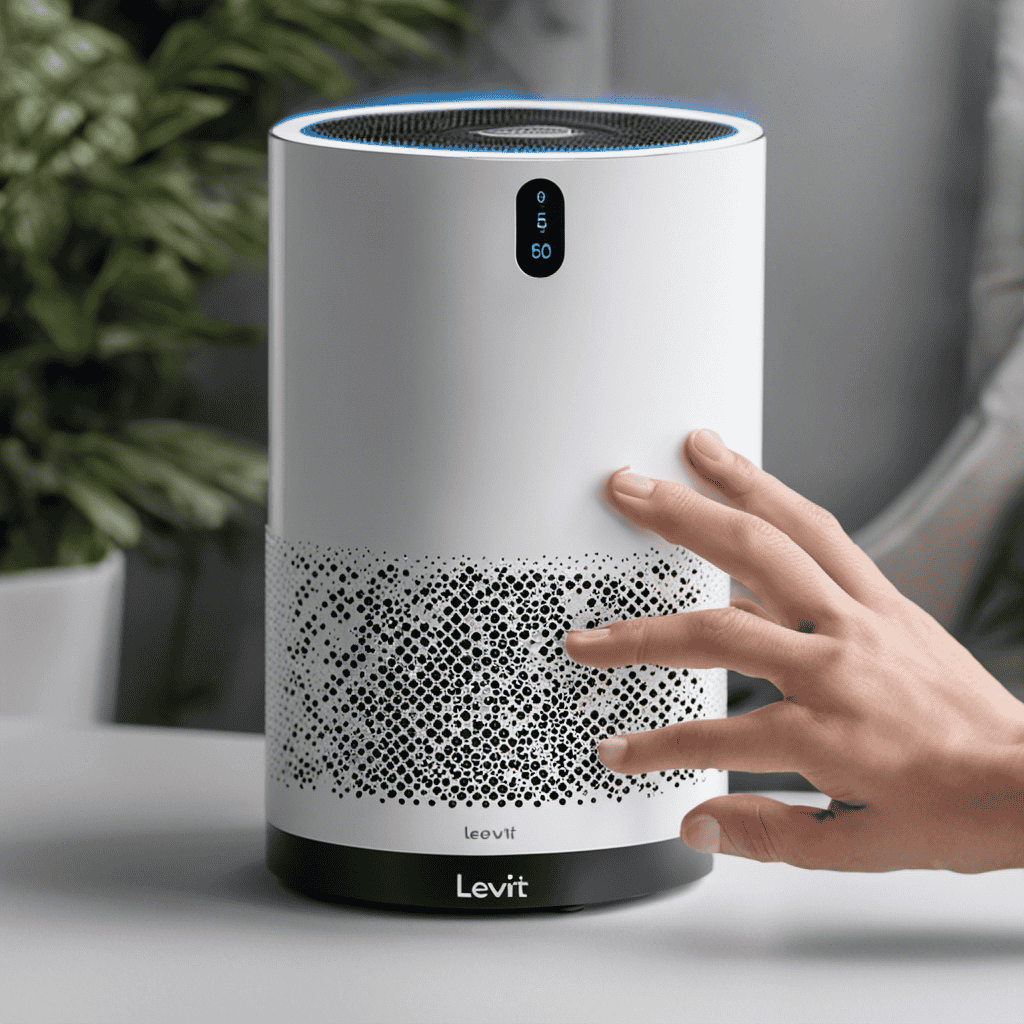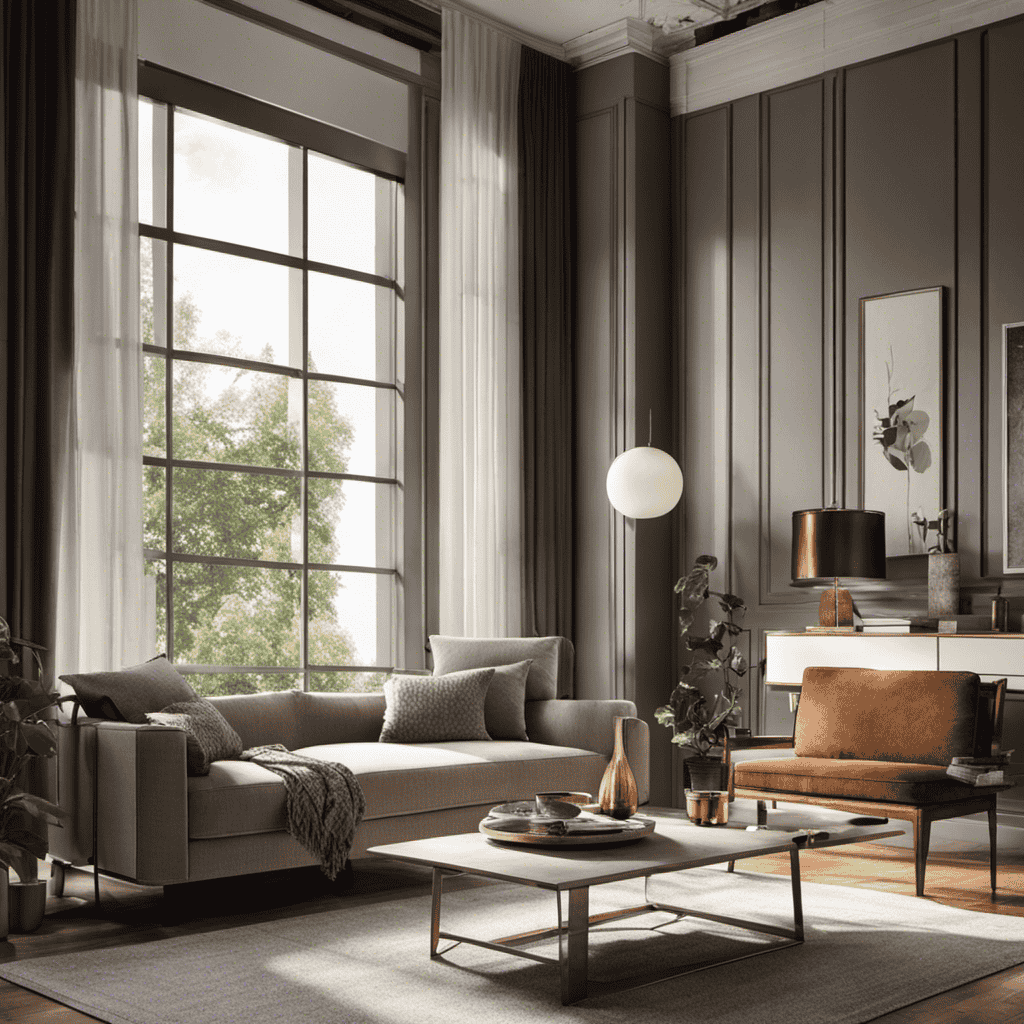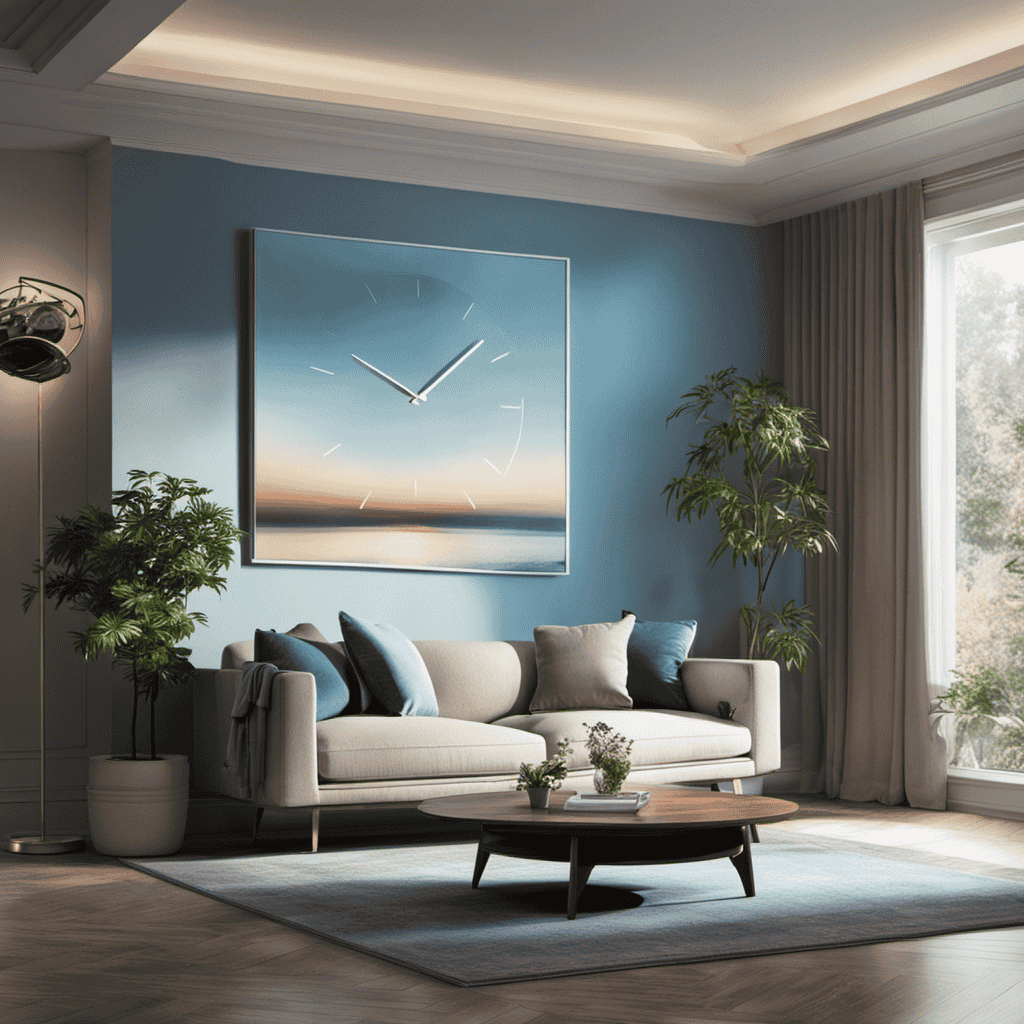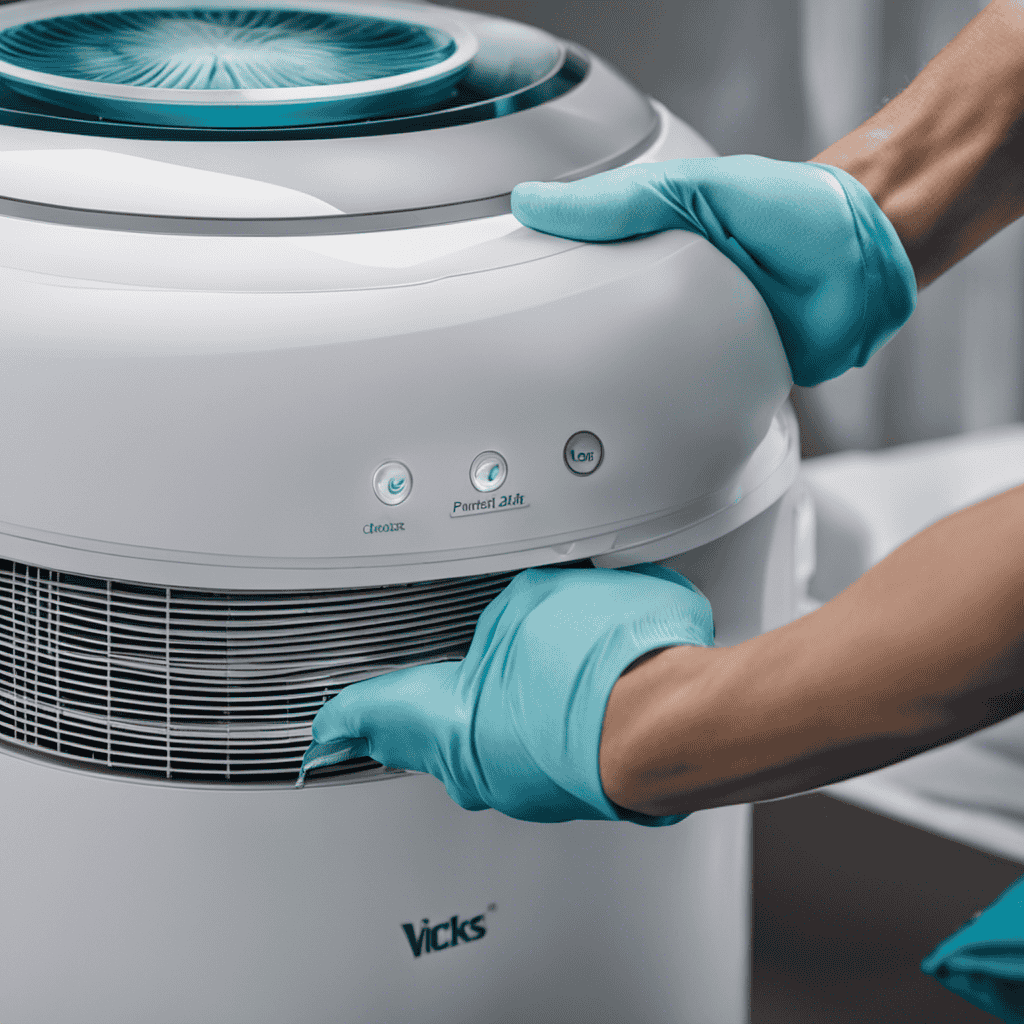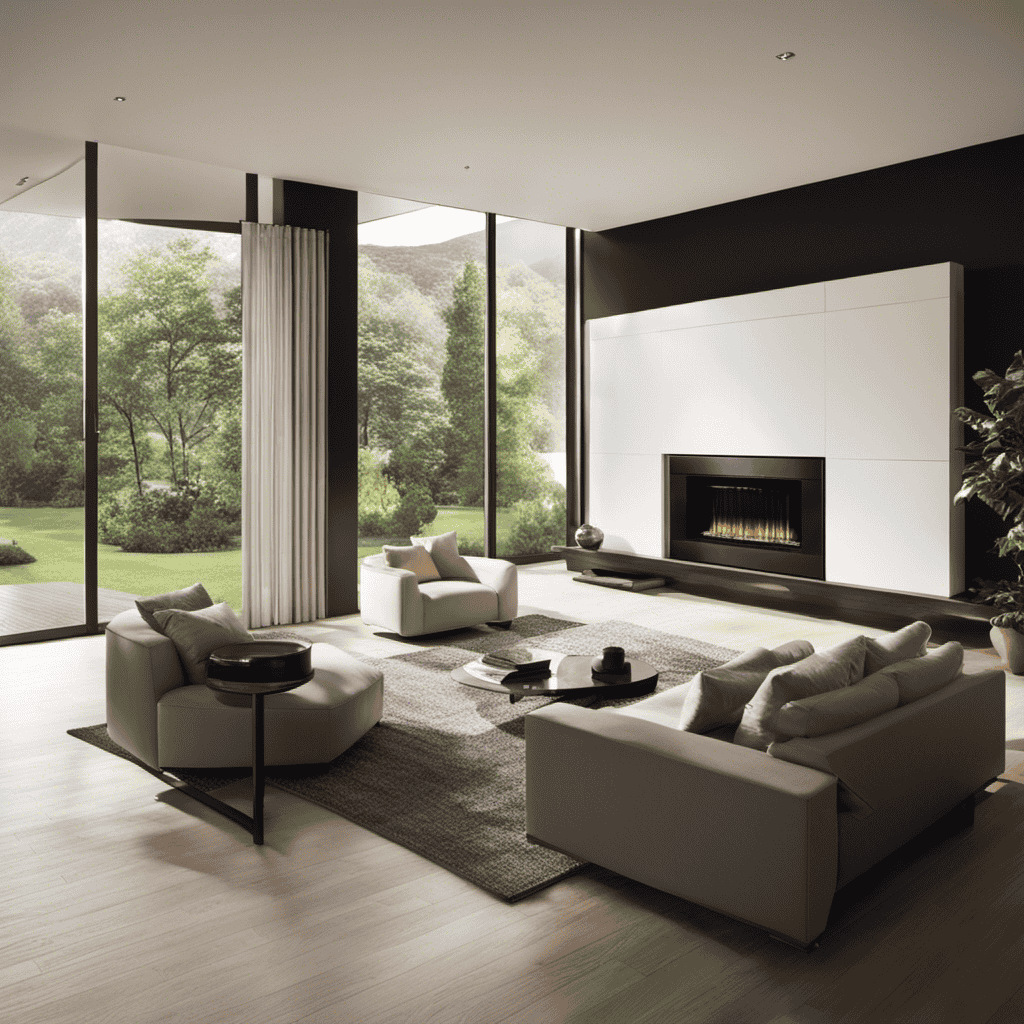As someone who is passionate about air quality, I have frequently thought about where to best position my reliable air purifier. Whether it be in the bedroom, living room, or even the kitchen, discovering the perfect spot can greatly impact the creation of a pristine and refreshing environment.
In this article, we’ll explore the optimal locations for your air purifier, from the nursery to the high traffic areas. So sit back, relax, and prepare to breathe easy with these expert tips on where to put your air purifier.
Key Takeaways
- Bedroom Placement: Improve air quality during sleep, safe distance from pets, regular maintenance.
- Living Room Placement: Arrange furniture for proper air circulation, avoid blocking vents, consider noise level.
- Kitchen Placement: Optimal placement for clean air, remove contaminants from cooking, position away from obstacles.
- Office Placement: Optimal placement near desk, consider size and coverage area, ensure comfortable fit.
Bedroom Placement
You should place the air purifier in your bedroom to improve the air quality while you sleep.
It is essential to choose a safe distance from pets to ensure their safety. Pets can knock over or damage the air purifier if it’s too close to them. Additionally, some air purifiers produce ozone, which can be harmful to pets when inhaled in large amounts.
To maintain your air purifier’s effectiveness, regular maintenance is necessary. This includes cleaning or replacing filters as recommended by the manufacturer. Neglecting maintenance can result in reduced performance and potentially harmful air pollutants circulating in your bedroom.
Living Room Placement
When it comes to optimizing air flow in the living room, there are a few key points to consider.
First, it is important to arrange furniture in a way that allows for proper air circulation throughout the space. This can be achieved by avoiding blocking vents or placing furniture directly in front of them.
Additionally, noise level concerns should be taken into account when choosing the placement of an air purifier. Ensuring that it is positioned in a way that minimizes disruption to the overall ambiance of the room.
Optimal Air Flow
To ensure optimal air flow, it’s important to place your air purifier in a location where it can easily circulate clean air throughout the room. Optimal positioning is crucial for the effectiveness of your air purifier. Make sure to keep it at least a few feet away from walls, curtains, and furniture to prevent any obstruction of air flow.
Additionally, avoid placing your air purifier directly in front of windows or doors, as this can disrupt the airflow. Regular maintenance is also essential to keep your air purifier working efficiently. Clean or replace the filters according to the manufacturer’s instructions, and keep the surrounding area clean to prevent dust buildup.
By following these maintenance tips and positioning your air purifier correctly, you can ensure that it effectively purifies the air in your room.
Now, let’s move on to the next section about furniture arrangement.
Furniture Arrangement
Placing furniture a few feet away from walls and windows allows for optimal air flow in the room. When arranging furniture, it’s important to consider how it affects the circulation of air in the space. Proper furniture placement can help improve the overall air quality and create a more comfortable environment. To help visualize the optimal placement, consider the following table:
| Furniture Placement | Effects on Air Flow |
|---|---|
| Against a wall | Restricts air flow |
| In front of a window | Blocks air circulation |
| Near a doorway | Disrupts air flow |
| Away from walls and windows | Promotes air circulation |
Noise Level Concerns
If you want to minimize noise levels in your living space, consider placing furniture strategically to act as sound barriers.
When it comes to air purifiers, finding one that operates quietly is crucial. Look for models specifically designed for quiet operation. These models are equipped with advanced noise reduction technology, ensuring a peaceful environment without compromising on air quality.
Additionally, consider placing the air purifier at a safe distance from children‘s play areas to prevent accidental tampering or damage. This will not only keep them safe but also maintain the effectiveness of the purifier.
Now, let’s move on to the next section about kitchen placement, where we’ll discuss the ideal location for your air purifier in this specific area of your home.
Kitchen Placement
In the kitchen, finding the optimal placement for an air purifier is crucial for ensuring clean and healthy air. One key consideration is achieving optimal air circulation, as this will help the purifier effectively remove contaminants and pollutants.
Additionally, it is important to identify potential sources of contaminants in the kitchen, such as cooking fumes, smoke, and volatile organic compounds, in order to strategically place the air purifier for maximum efficiency.
Optimal Air Circulation
To ensure the optimal air circulation in your space, make sure to position the air purifier in an open area away from obstacles. When considering furniture arrangement, it is important to place the air purifier in a location where it can effectively reach all corners of the room. Avoid placing it directly behind or underneath furniture, as this can obstruct the airflow and limit its effectiveness.
Additionally, consider noise level concerns when choosing the placement. While air purifiers generally operate quietly, it is still recommended to position it away from areas where you spend a lot of time, such as your bed or desk, to avoid any potential disturbances.
By following these guidelines, you can ensure that your air purifier is able to circulate clean air efficiently throughout your space, creating a healthier environment for you and your family.
Now that we have discussed the optimal air circulation, let’s move on to the next section about potential contaminant sources.
Potential Contaminant Sources
Identify the potential contaminant sources in your space, such as dust, pollen, pet dander, and mold, to better understand the specific pollutants that your air purifier needs to target. Here’s a table to help visualize different sources and their impact on air quality:
| Contaminant Source | Impact on Air Quality |
|---|---|
| Dust | Reduced air quality |
| Pollen | Allergens |
| Pet Dander | Allergens |
| Mold | Health risks |
When considering the placement of your air purifier, take into account the furniture arrangement in your space. Ensure that the purifier is placed in an area where it can effectively circulate air and reach all corners of the room. Additionally, consider noise level concerns. If you are sensitive to noise, place the purifier away from areas where you spend most of your time, such as your bed or desk.
With the potential contaminant sources identified and the furniture arrangement and noise level concerns taken into consideration, let’s now explore the optimal placement of your air purifier in your office space.
Office Placement
Consider placing the air purifier near your desk for optimal office air quality. This placement allows the purifier to effectively filter the air in your immediate vicinity, ensuring that you breathe in clean and fresh air while you work.
When considering the optimal desk placement for your air purifier, there are a few size considerations to keep in mind:
- Size of the air purifier:
- Ensure that the purifier is compact enough to fit comfortably on or near your desk without causing any obstruction.
- Make sure it has a sufficient coverage area to effectively purify the air in your workspace.
By considering these factors, you can ensure that your air purifier is placed optimally for maximum efficiency in your office.
Now, let’s discuss the next section about ‘nursery placement’ to enhance the air quality in your child’s room.
Nursery Placement
When it comes to placing an air purifier in the nursery, there are two key points that need to be considered: the safe distance from the crib and the noise level.
It is important to ensure that the air purifier is placed at a safe distance from the crib to avoid any potential harm or disturbance to the baby.
Additionally, the noise level of the purifier should be taken into account to ensure a peaceful and quiet environment for the baby to sleep in.
Safe Distance From Crib
It’s important to place the air purifier at a safe distance from the crib to avoid any potential risks. Here are some considerations to keep in mind:
-
Safe distance from pets: Ensure that the air purifier is positioned far enough from your furry friends. This will prevent them from knocking it over or tampering with the device. Keep in mind that some air purifiers emit a low-level ozone, which can be harmful to pets. Placing it at a safe distance will minimize their exposure.
-
Safe distance from electronics: Avoid placing the air purifier too close to electronics, such as TVs or computers. The airflow from the purifier may interfere with the functioning of these devices. Additionally, electronics generate heat, and placing the purifier too close can potentially cause overheating or damage.
Considering these factors will ensure the air purifier operates effectively without posing any risks to your pets or electronics.
Now, let’s discuss noise level considerations.
Noise Level Considerations
After considering the safe distance from the crib, it’s important to also consider noise level when deciding where to put an air purifier.
The placement of furniture and the proximity to the kitchen can greatly impact the noise level in a room. If the air purifier is placed near the kitchen, it may be exposed to the noise generated by appliances like blenders or dishwashers. This can be disruptive, especially during meal preparation or cleanup times.
To minimize noise, it’s best to place the air purifier away from the kitchen or any other sources of noise. Ideally, it should be placed in a quiet corner of the room or in an area where it won’t be affected by regular activities.
Basement Placement
For basement placement, you’ll want to ensure that the air purifier is positioned near the main source of air pollution. This will maximize its effectiveness in removing contaminants and improving air quality.
To further optimize its performance, consider the following:
-
Safe Distance from Pets:
Although air purifiers are generally safe for pets, it’s important to place them at a safe distance from your furry friends to prevent them from knocking it over or tampering with the filters. -
Humidity Control:
Basements tend to be more humid than other areas of the house, which can promote mold growth. Look for an air purifier that includes a built-in dehumidifier or consider using a separate dehumidifier to maintain optimal humidity levels.
Garage Placement
When it comes to placing an air purifier in the garage, there are a few key points to consider.
First, airflow and ventilation are crucial in ensuring that the air purifier can effectively circulate and filter the air in the space.
Secondly, deciding whether to mount the unit on the wall or ceiling can impact its performance and convenience.
Lastly, it’s important to find the optimal location that allows for easy access to the air purifier while still maximizing its effectiveness in purifying the air in the garage.
Airflow and Ventilation
To ensure proper airflow and ventilation, make sure you place the air purifier in a central location within the room. This will allow the air purifier to effectively circulate and filter the air throughout the entire space.
Here are some important tips for air purifier maintenance and filter replacement:
-
Regularly clean the air purifier: Dust and debris can accumulate on the exterior and interior components of the air purifier. Wiping it down with a damp cloth and removing any build-up will help maintain its efficiency.
-
Replace the air purifier filter: The filter is a crucial component that traps and removes airborne particles. It is important to follow the manufacturer’s recommendations for filter replacement, as a clogged or dirty filter can hinder the performance of the air purifier.
Taking these steps will ensure that your air purifier functions optimally and provides you with clean and fresh air.
Wall or Ceiling Mounting
When it comes to mounting an air purifier, there are two popular options: wall mounting or ceiling mounting. Both options have their advantages, and the choice ultimately depends on the layout and design of the room.
Wall mounting an air purifier offers the advantage of easy access for maintenance and filter changes. It also allows for optimal height placement, ensuring efficient air purification throughout the room. On the other hand, ceiling mounting can provide better coverage and distribution of purified air, particularly in larger spaces.
To help you make an informed decision, here is a table comparing the two mounting options:
| Wall Mounting | Ceiling Mounting |
|---|---|
| Easy access for maintenance | Better coverage in large spaces |
| Optimal height placement | Improved air distribution |
Regardless of the mounting option you choose, the installation process is typically straightforward and can usually be done with basic tools. Just follow the manufacturer’s instructions and ensure that the air purifier is securely mounted to avoid any accidents or damage.
Bathroom Placement
You can place the air purifier in the bathroom to help improve the air quality.
When considering where to put it, there are a few factors to keep in mind.
Firstly, it is important to maintain a safe distance from the toilet. This will prevent any accidental damage or interference with the purifier’s functionality.
Secondly, you should consider the humidity levels in the bathroom. High levels of humidity can affect the purifier’s performance and potentially cause damage. To address this, you can choose an air purifier with a built-in humidity sensor or place a dehumidifier nearby to regulate the moisture.
Dining Room Placement
Consider placing the air purifier in your dining room to improve the air quality and create a healthier environment for you and your family.
The dining room is often a central area in the home where the whole family gathers for meals. By placing the air purifier here, you can ensure that everyone is breathing clean, purified air while enjoying their meals.
When considering furniture arrangement, make sure to place the air purifier in a location where it can effectively circulate air throughout the room. Additionally, noise level concerns may arise when choosing the right placement. It’s important to choose an air purifier that operates quietly, so as not to disrupt conversations or meal times.
With the air purifier in your dining room, you can breathe easy and enjoy a healthier living space.
Now, let’s move on to discussing the placement of an air purifier in the laundry room.
Laundry Room Placement
Now let’s talk about placing an air purifier in the laundry room. This is an important area to consider because the laundry room can accumulate dust, lint, and other particles that can affect air quality.
When choosing a spot for your air purifier, keep these safe installation and maintenance tips in mind:
-
Placement:
-
Position the air purifier at least 3 feet away from the washer and dryer to prevent any interference with their operation.
-
Place it on a stable surface, like a countertop or shelf, to ensure it won’t be knocked over easily.
-
Maintenance:
-
Regularly clean and replace the filters according to the manufacturer’s instructions to maintain optimal performance.
-
Keep the area around the air purifier clean to prevent the accumulation of dust and debris.
Gym Placement
When choosing a spot for your gym equipment, make sure to select a location that is spacious and well-ventilated.
The optimal gym size will depend on the type and quantity of equipment you have. You want to ensure that there is enough space for you to move around and perform your exercises comfortably.
Additionally, a well-ventilated area is crucial to maintain good air quality during your workouts. Poor air quality can lead to respiratory issues and decrease your overall performance.
Consider installing air quality monitoring devices in your gym to keep track of the air pollution levels. This will help you identify any potential problems and take necessary steps to improve the air quality.
Ultimately, choosing the right location and monitoring the air quality will create a healthier and more enjoyable workout environment.
Pet Area Placement
The best spot for your pet area is a well-ventilated and spacious location that allows them to move around comfortably. When considering where to place your pet area, keep in mind the following:
- Ensure the area is at a safe distance from any potential hazards or dangers, such as electrical outlets or fragile items.
- Create a designated space that is easily accessible for your pet, with enough room for them to play, eat, and rest.
- Provide allergy relief by keeping the pet area away from areas prone to dust or pollen accumulation.
- Consider using an air purifier in the vicinity to help minimize allergens and improve indoor air quality.
Allergy Relief Placement
To minimize allergens and improve indoor air quality, you’ll want to consider using an air purifier in the vicinity of your pet area.
However, if you’re looking for allergy relief throughout your home, it’s important to strategically place your air purifier in areas where you spend the most time.
One key area to consider is your bedroom. Since we spend a significant amount of time in our bedrooms, having clean and allergen-free air is crucial for a good night’s sleep.
By placing an air purifier in your bedroom, you can effectively filter out allergens such as dust mites, pollen, and pet dander that can trigger seasonal allergies.
Additionally, when choosing an air purifier for your bedroom, consider one that complements your bedroom decor and operates quietly, ensuring a peaceful environment for sleep.
High Traffic Area Placement
Placing an air purifier in a high traffic area like the living room can greatly improve indoor air quality. Here are a few reasons why this is an ideal location:
-
Furniture Arrangement:
The living room is usually the central gathering space in a home, making it easier to position the air purifier where it can effectively circulate and clean the air. Placing the purifier near seating areas or close to where people spend the most time ensures that they are breathing in the cleanest air. -
Noise Level Concerns:
Modern air purifiers are designed to operate quietly, but it’s still important to consider noise levels. Placing the purifier in the living room allows for better noise dispersion throughout the house. The ambient noise in a high traffic area like the living room can help mask any minimal noise produced by the air purifier.
Multi-Level Home Placement
When it comes to placing an air purifier in a multi-level home, there are both advantages and disadvantages to consider. On one hand, having multiple levels means that you can strategically place air purifiers on different floors to ensure clean air throughout the entire house. This can be especially beneficial if you have family members with allergies or asthma, as it allows you to target specific areas where they spend the most time. However, the downside is that you may need to invest in multiple units, which can be costly. Additionally, moving the air purifiers between floors can be a hassle. To help you decide, here’s a table summarizing the advantages and disadvantages of placing an air purifier in a multi-level home:
| Advantages | Disadvantages |
|---|---|
| Clean air on every floor | Cost of multiple units |
| Target specific areas | Moving units between floors |
| Allergy and asthma relief | |
| ——————————– | ———————————- |
Overall, the decision to place air purifiers in a multi-level home depends on your specific needs and budget.
Frequently Asked Questions
How Do I Know if My Air Purifier Is Suitable for a Bedroom?
I can determine if my air purifier is suitable for the bedroom by checking the signs of poor indoor air quality, such as allergies or respiratory issues. Using an air purifier in the bedroom has many benefits, including cleaner air and improved sleep quality.
Can I Place an Air Purifier in the Kitchen to Get Rid of Cooking Odors?
Yes, you can place an air purifier in the kitchen to eliminate cooking odors. It helps to have an air purifier with effective filters that can capture and remove the odors, improving the air quality in your kitchen.
Is It Safe to Use an Air Purifier in a Nursery?
It is safe to use an air purifier in a nursery. Regular air purifier maintenance ensures optimal performance. The benefits of using one in a nursery include removing allergens, pollutants, and odors for a cleaner and healthier environment.
Should I Place an Air Purifier in the Bathroom to Eliminate Moisture and Odors?
Placing an air purifier in the bathroom can be beneficial for eliminating moisture and odors. It helps improve air quality and reduce the risk of mold and mildew growth.
Where Should I Position an Air Purifier in a Multi-Level Home for Maximum Effectiveness?
I found that the best position for an air purifier in a multi-level home is on each level, strategically placed in areas where air circulation is high. This maximizes the effectiveness of the purifier in improving indoor air quality.
Conclusion
After exploring various placement options for an air purifier, it is clear that its effectiveness depends on where it is placed. Whether it’s the bedroom, living room, kitchen, office, nursery, or pet area, finding the right spot is crucial for optimal results.
Additionally, placing an air purifier in allergy-prone areas or high traffic areas can provide much-needed relief. And let’s not forget about multi-level homes, where multiple purifiers may be needed to cover all floors.
So, when it comes to air purifiers, remember that placement is key for a breath of fresh air.

